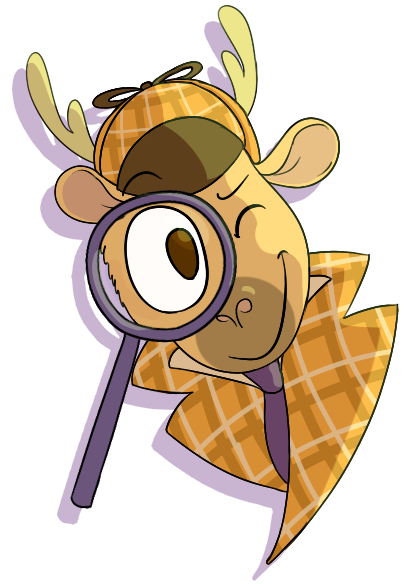Detective Work on Calcrostic Problems

Solving a calcrostic is like checking out a crime scene for clues. The following are examples, how to get clues from single lines of the puzzle.
For example, if the row, column or diagonal is
-
a × b = a
thenamust be 0 orbmust be 1. It is easy to find out which case applies. We look at other lines that includeaandb. For example, ifa=0thenc + a = cand ifb=1thenc + b = d. Similarly, froma ÷ b = afollowsa=0orb=1and from each ofcd × b = cd,cd ÷ b = cdfollowsb=1. -
a + b = cd
then it follows thatc=1because the sum of two 1-digit numbers can not be more than 9+9=18 and if both are different then not more than 9+8=17. The same conclusion can be made fromcd − b = a.
-
a × b = c
then what is special is that the result is only a one digit number, so less than 10. Also,a, b, care all different, so none of them can be 1 or 0. Thus, one ofa, bmust be 2 and the other one 3 or 4 andcis 6 or 8. The same conclusion can be drawn fromc ÷ b = a.
-
a × a = b
thenbis a square number unequalaandb<10, soa=2, b=4ora=3, b=9. -
c + ea = eg
then the first digit (the tens) ineaand inegare the same, so we conclude thatc + a = g. -
c + ea = fg
then the first digit (the tens) ineaand infgare different. This can only be due to a carry over, so we conclude thate + 1 = fandc + a = 10 + g. - If a number has more than one digit then the leftmost digit can be assumed to be non-zero. If a puzzle is large and has 10 different letters then this easy to get information may even be sufficient to tell which letter has the value 0.
-
..a × ..b = ..5
thenaorbis 5 and the other one is an odd digit. -
..a × ..b = ..7
then the only possible values ofaandbare 3 and 9. The product of 1 and 7 does also end at 7 but ifaorbwould be 7 then this would be known. -
..a × ..b = ..3
then the only possible values ofaandbare 7 and 9. The product of 1 and 3 does also end at 3 but ifaorbwould be 3 then this would be known. -
..a × ..a = ..9
then the only possible values ofaare 3 and 7. -
..a × ..b = ..1
then the only possible values ofaandbare 3 and 7. -
..a × ..a = ..1
then the only possible values ofaare 1 and 9. -
..a × ..b = ..a
This clue is the same as the very first clue but more general with more digits that may appear to the left ofaandb. This clue appears relatively often. By looking only at the units position it follows thata × b = a + k × 10wherekis the carry-over from the multiplication. It follows thata × (b-1) = k × 10. In other words,a × (b-1)must be divisible by 10! Apart from the two cases known from the first clue: (a = 0) or (b-1 = 0) we only have 2 more cases to consider: (a = 5andbis odd) or (b-1 = 5andais even). - If logical reasoning does not help to determine more values then one has to guess and consider different cases. If one only wants to find one solution and not all then one should consider most likely cases first. What is likely and what not? From the above discussion we learned that it is unlikely for the unit value of a product to be 7, 3 or 1.
- All statements made above about products equally apply to quotients.
- Left most digits of multiple digit numbers can not be zero.
- If the calcrostic involves not only integers but also rational numbers then one can draw more conclusions:
- The leftmost digit in numerator and denominator can not be zero. If the numerator or denominator is a single digit then this can not be zero either.
- If the denominator is a single digit, then this is not equal 1.
- Because numerator and denominator are co-prime, the unit digits of numerator and denominator can not both be even. Also, if both unit digits are the same letter then they can not be 5 and if they are not the same letter then it can not be the case that one is 0 and the other is 5.

Try to find more clues, for example:
-
What can be concluded from a × a = ba? Which values cana, bonly have?
-
What follows from eb × c = cd? Which value caneonly have?
-
If you know that g = 1then what doesfg ÷ c = dtell you aboutf, c, d?
Let us solve one puzzle:
ab + c = dd
× − −
e + f = c
= = =
fb ÷ e = ab
The last clue above applies to the first column. We therefore have 4 cases:
- b=0(not possible otherwise the first row should giveab + c = ..c),
- e=1(not possible otherwise in the first columnab × 1 = ab)
- e-1=5, i.e.e=6andbeven: 1. column: ifab × 6is a 2-digit number (fb) thena=1because already 20×6=120 results in a 3-digit number. Witha=1from the first row then followsd=2because the ten unit can increase only by 1 when adding a 1-digit number.bhas to be even in this 3rd case butb<>0, b≠2becaused=2, b≠6becausee=6, b≠8because from 1st column 18×6>100. Thereforeb=4, from 1st rowc=8and from 2nd rowf=2which contradictse=2. Therefore case 3) does not apply.
- b=5ande-1is even, i.e.eis odd: It follows thate=3becausee≠1(case 2),e≠5(becauseb=5),e<7(because in 1st column 15×7>100). Forawe have the constraints:a≠2(because otherwise from 1st row followsd=a+1=3but we already havee=3) anda<>3(becausee=3),a<4(because from 1st column 45×3>100 and not a 2-digit number). Thereforea=1, from 1st rowd=2, c=dd - ab = 22-15=7, from 2nd rowf=c-e=7-3=4giving us the solution
15 + 7 = 22 × − − 3 + 4 = 7 = = = 45 ÷ 3 = 15
Have fun when trying our problem of the day!
Video solutions with more hints are available for the following calcrostics problems from Caribou contests:
- November 2011, grade 7/8 question 23
- October 2011, grade 7/8 question 17
- May 2011, grade 7/8 question 17
- November 2012, grade 5/6 question 18
- April 2013, grade 3/4 question 11
- April 2014, grade 3/4 question 12
- May 2015, grade 3/4 question 12
- October 2015, grade 3/4 question 11
- November 2015, grade 9/10 question 15





Follow or subscribe for updates: